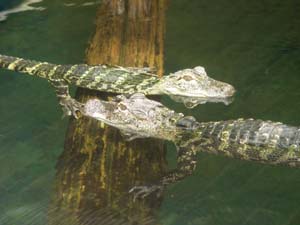|
November
2004 Tar Heel Travels

State Aquariums
Venture
into the mysterious world beneath the waves
By Bill F. Hensley
In
case you have missed them — and it’s a shame if you have — there are three
lively, entertaining and educational facilities on our coast where you can see a
shark or an alligator being fed, take a photo of an eel, touch a turtle, mingle
with a stingray, or lure a jellyfish.
These are the state’s aquariums, which were created nearly 30 years ago to
promote awareness, understanding, appreciation and conservation of our aquatic
natural resources. They are Fort Fisher, in the Wilmington area; Pine Knoll
Shores, near Morehead City; and Roanoke Island, at the gateway to the famed
Outer Banks. All are fully accredited by the American Zoo and Aquariums
Association and are administered by the N.C. Department of Environment and
Natural Resources.
All three offer a wide range of activities. You can talk to a deep sea diver,
learn the difference between a whelk and a conch shell, find out if a salamander
is slimy, make a wreath from a coastal treasure, or test your ocean knowledge.
Outside, you might wander through misty wetlands, watch the otters at play,
learn to surf, take a river cruise, join a seaside scavenger hunt, explore a
salt marsh, or catch a blue crab.
The three multi-purpose marine centers are well-planned, well-designed,
state-supported facilities that have become top tourist attractions. Together
they drew more than a million visitors last year, adding an estimated $27
million to the state’s economy. As positive word-of-mouth advertising spreads,
attendance continues to rise.
Each facility includes colorful aquarium displays, touch tanks, interactive
exhibits, live animal programs, marine related arts and crafts programs, plus
teacher workshops. There also are classrooms and meeting rooms, field trips,
boat trips and lectures.
“Education is a major focus,” says Fort Fisher public relations coordinator
Rob Roush. “We offer a wide variety of experiences for families, students,
teachers and other groups. Each year our state aquariums play host to about
60,000 students who see our unique environmental settings firsthand.”
The aquariums were created in 1976 at a cost of $4.6 million. A major renovation
and expansion program doubling each in size began in 1989 at a projected cost of
more than $50 million. To date, work has been completed at Roanoke Island and
Fort Fisher. The Pine Knoll Shores project is expected to be completed in 2006.
“So far, our expanded facilities have been quite popular with the public,”
Roush said, “ And our future looks brighter as we develop new ways to educate
and entertain our visitors.”
At Fort Fisher, 15 miles south of Wilmington, the unique 24-foot deep Cape Fear
Shoals exhibit houses more than 300 sea creatures. Sharks, groupers, eels and
stingrays are among 50 species that swim through the deep-sea canyons of a
spectacular offshore reef habitat.
There are five separate viewing windows on two levels for close looks at a
sea-bottom gorge in this 235,000-gallon exhibit. Several times a day divers
enter the tank for routine cleaning and maintenance chores. Twice daily they
talk to viewers via an underwater communication system.
Another major exhibit is the 20,000-square-foot Cape Fear Conservatory, an
enormous glass-covered atrium where the visitor encounters ponds and waterfalls,
trees and ferns, turtles and alligators, and a variety of freshwater fish,
including the shortnosed sturgeon whose survival is now threatened.
There also is a collection of aquatic snakes — poisonous and non-poisonous —
that is sure to evoke a squeal or two from the young folks.
Meanwhile, adults will be interested in seeing a Venus flytrap amid an
interesting display of carnivorous plants, trees and ferns. This plant grows
only within a 75-mile radius of Wilmington and is found nowhere else in the
world.
After visiting the Roanoke Island aquarium in Manteo, sportfishing fans should
check out Jennette’s Pier in Nags Head, which has been acquired by the N.C.
Aquarium Society, a private organization that provides major funding for the
aquariums.
On display at the recently renovated pier house, which was nearly destroyed
during Hurricane Isabel, are models of 39 state record fish. The new Giants of
the Sea exhibit includes a 150-pound wahoo, a 100-pound sailfish, a 125-pound
amberjack and a 744-pound bluefin tuna. All represent the largest of their kind
caught in North Carolina waters.
Large tanks with live fish collected near the pier will soon be added.
“Jennette’s Pier is taking on a new life,” says general manager Mike
Remige. “This is the place to fish and learn about the ocean environment.”
Remige notes that the pier is a saltwater fishing attraction catering to
families, and that the Roanoke Island Aquarium coordinates all of its programs.
The aquariums are open from 9 a.m. to 5 p.m. daily except Thanksgiving,
Christmas and New Year’s Day. Admission is $7 for adults, $6 for seniors and
active-duty military personnel, and $5 for kids 6-17. Veteran’s Day, Martin
Luther King Day, Valentine’s and Christmas Eve are admission-free days.
For more information, including program schedules, visit www.ncaquariums.com
or call 910-458-6812.
|